
Standard Chartered - monthly outlook (en)_watermark
.pdf
vk.com/id446425943
Macro Strategy | 2 July 2019
Global Market Outlook
Taking out insurance
Our Global Investment Committee’s central scenario is the Fed’s ‘insurance’ rate cuts will help ensure the current growth slowdown is a temporary soft-spot rather than the early stages of a recession.
We continue to have a preference for equities over bonds, and Emerging Market and corporate bonds over Developed Market government bonds. Within equities, we have a tilt towards the US.
We see gold as a good way to hedge downside risks, especially given our soft USD outlook and potential equity market weakness in the coming 1-3 months.
This reflects the views of the
Wealth Management Group

vk.com/id446425943
Standard Chartered Bank
Global Market Outlook | 2 July 2019
01
02
03
04
05
HIGHLIGHTS
01 Taking out insurance
STRATEGY
03 Investment strategy
PERSPECTIVES
07 Perspectives on key client questions
10 Macro overview
ASSET CLASSES
14Bonds
15Equities
17 Foreign exchange
20 Technical perspectives
PERFORMANCE REVIEW
21Market performance summary
22Events calendar
25How we generate investment views: Our adaptive process
26Disclosure appendix
This reflects the views of the Wealth Management Group |
2 |

vk.com/id446425943
|
Standard Chartered Bank |
|
Global Market Outlook | 2 July 2019 |
2 |
Investment strategy |
Taking out insurance
•Our Global Investment Committee’s central scenario is the Fed’s ‘insurance’ rate cuts will help ensure the current growth slowdown is a temporary soft-spot rather than the early stages of a recession.
•We continue to have a preference for equities over bonds, and Emerging Market (EM) and corporate bonds over Developed Market (DM) government bonds. Within equities, we have a tilt towards the US.
•We see gold as a good way to hedge downside risks, especially given our soft USD outlook and potential equity market weakness in the coming 1-3 months.
2019 better than 2018, but can this trend extend?
Asset markets rebounded strongly in H1 2019 following a poor 2018. Global equities led the way, rising over 10%, but bonds (particularly riskier bonds) also performed well. Oil has rallied and gold recently broke higher. However, analysts have become more cautious on the outlook for global equities over the past month amid slowing economic growth, continued US-China trade tensions and a reinversion of the US yield curve (10-year yield falling below the 3-month yield).
The key question we face today is whether these H1 market trends will extend through H2 and into 2020, particularly as equity and bond markets offer potentially conflicting signals and major central banks are considering easing policy.
Long-term factors argue cycle has room to run
We compare the current situation to the previous four Fed easing cycles to determine whether we are witnessing a temporary soft patch (as in 1995 and 1998) or the precursor to a recession (2001 and 2007). Of the six factors, only two are negative, while the rest are either supportive or neutral. While this may not appear to present a compelling case for risk assets, it is significantly better than seen in 2001 and 2007 (five and four negative factors, respectively). Therefore, we believe the Fed’s insurance interest rate cuts will extend the economic cycle warranting a continued preference for risk assets on a 6-12 month horizon. We would likely need to see more signs of inflation pressure and/or financial excesses before considering dialling back risk in investment allocations.
Figure 1
EM has outperformed in 2019 across both equities and bonds
Total returns of major asset classes and top/bottom performing markets within each 10-Dec-2018 to 28-Jun-2019 (since publication of Outlook 2019)
|
|
15.0% |
|
|
|
|
|
|
|
|
|
|
12.8% |
|
|
|
|
|
|
|
|
13.3% |
|
|
|
|
|
|
12.0% |
|
|
|
|
|
|
|
||
|
|
|
|
|
|
|
|
|
|
|
|
|
|
|
|
|
|
|
|
|
10.6% |
|
|
|
|
|
|
|
|
|
|
|
9.0% |
|
|
|
|
|
|
|
|
|
|
|
|
|
|
8.0% |
|
|
|
|
|
|
|
6.7% |
|
|
|
|
|
|
6.9% |
|
|
|
|
4.6% |
|
|
5.2% |
|
|
|
|
|
|
|
|
|
|
|
|
|
|
|
|
|
|
|
|
|
|
|
|
|
|
|
|
|
|
|
|
|
Equ itie s |
EM |
Japan |
Glo bal |
EM |
EU |
Global |
US IG |
US HY |
Gold |
Brent |
|
|
World |
Ex-Asia |
|
IG Gov |
Sovere ign Sovereign |
IG Corp |
Corp |
Corp |
|
|
|
|
|
|
|
|
Bon ds |
(USD) |
|
Bon ds |
Bon ds |
Bon ds |
|
|
|
|
|
Equities |
|
Sovereign bonds |
|
Corporate bonds |
Commodities |
|||||
|
|
|
|
|
|
|
|
|
|
|
|
|
Source: Bloomberg, Standard Chartered
IMPLICATIONS
FOR INVESTORS
Equities likely to outperform other asset classes. We have a slight preference for the US
EM USD government bonds most likely to outperform within our bond universe
Gold a good way to hedge downside risk amid our outlook for a weaker USD
This reflects the views of the Wealth Management Group |
3 |
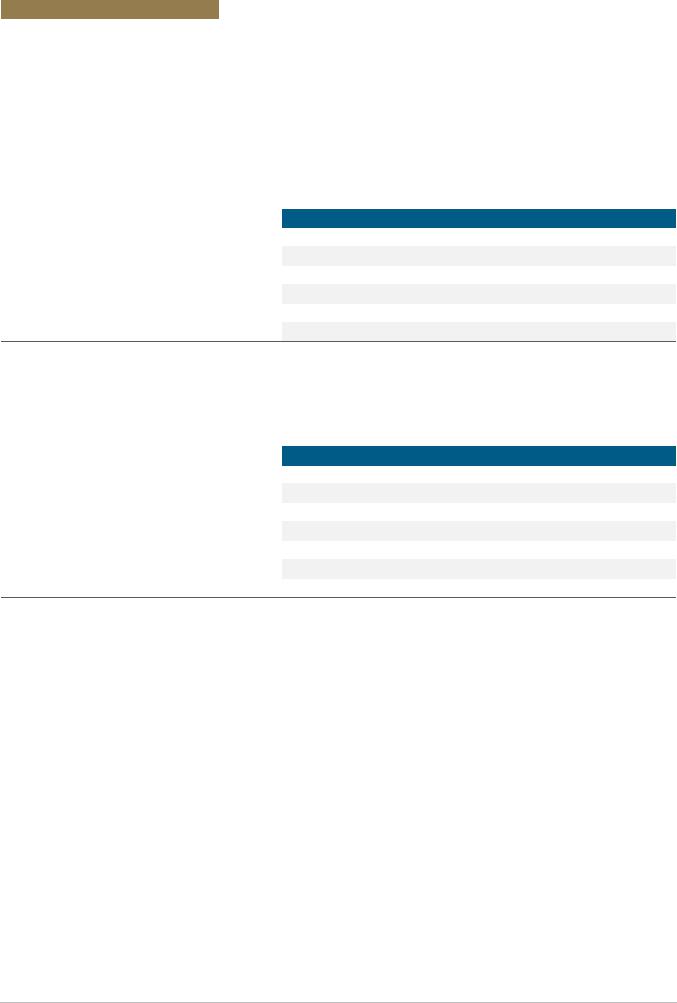
vk.com/id446425943
Standard Chartered Bank
Global Market Outlook | 2 July 2019
Figure 2
Medium-term factors argue for a reasonably constructive outlook
Factors influencing risk assets over 12-24 months – our assessment
Medium-term factors |
Current signal |
|
Prior to mid-cycle rate cut (1995/8) |
Valuations |
|
|
/ |
|
|
|
|
US unemployment rate |
|
|
/ |
US monetary policy settings |
|
|
/ |
Inflation expectations |
|
|
/ |
Geopolitics |
|
|
/ |
Financial excesses |
|
|
/ |
Source: Standard Chartered |
|
|
|
Legend: Supportive for risk assets |
Neutral |
Negative for risk assets |
|
Prior to recession rate cut (2001/7)
/
/
/
/
/
/
Figure 3
Short-term factors are more mixed
Factors influencing risk assets over 1-3 months – our assessment
Short-term factors |
Current signal |
Prior to mid-cycle rate cut (1995/8) |
Consensus earnings |
|
/ |
|
|
/ |
Business confidence |
|
|
US financial conditions |
|
/ |
|
|
/ |
Technicals |
|
|
Market diversity |
|
/ |
|
|
|
Event risks |
|
/ |
Seasonality |
|
/ |
Source: Standard Chartered
Legend: |
|
Supportive for risk assets |
|
Neutral |
Negative for risk assets |
|
|
Prior to recession rate cut (2001/7)
/ / /
/
/
/
/
Geopolitics is clearly an area of concern. While risks are impossible to quantify and difficult to factor into decisionmaking, they argue for a less aggressive investment stance than would otherwise be the case. In our view, trade tensions are a symptom of the shift from a US-centric world order to a more multi-polar one amid rising Chinese economic, military and political power. To what degree the
US accepts China’s increased role in global affairs will be key to the evolution of US-China tensions in the coming years.
Another concern is the low US unemployment rate, lower than in the run-up to either the 2001 or 2007 recessions. While this is good from a socio-economic perspective, it shows the US economy may be getting close to full capacity, which could raise inflationary pressures.
However, other factors are more positive. Productivity gains have largely offset recent wage growth, and inflation expectations have actually been falling. This allows the Fed to offset slowing growth without worrying about inflationary
consequences, at least for now. Thus, US monetary policy settings are likely to become more supportive.
Meanwhile, we believe there are few signs of significant financial excesses akin to the 2001 ‘dot com’ boom or the 2007 US real estate market worries. Today, while concerns have been expressed about US banks’ exposure to student loans and the increased reliance of sub-investment grade issuers on covenant-lite floating rate debt, our view is these exposures are insufficient to trigger the end of the cycle.
Short-term outlook more mixed
While the medium-term picture looks reasonably constructive in our assessment, shorter-term factors tell a different story. On the positive side, earnings and economic expectations are currently more supportive than prior to previous midcycle and end-of-cycle interest rate cuts. While business confidence has fallen, the US ISM index remains above 50, which suggests the industrial sector is experiencing a slowdown rather than an outright contraction.
This reflects the views of the Wealth Management Group |
4 |

vk.com/id446425943
Standard Chartered Bank
Global Market Outlook | 2 July 2019
Event risks today are elevated, similar to the run-up to the
1995 (Latam ‘tequila’ crisis) and 1998 (LTCM, Russian debt crisis) episodes, although, arguably, today’s trade risks are more manageable than prior concerns about debt dynamics.
However, technicals, market diversity and seasonality are flashing amber. The recent trend has been positive, but global equity markets have recently tested key resistance levels, which may be tough to break short term. Meanwhile, market diversity has fallen and is getting closer to levels suggesting an imminent reversal. The seasonally weak summer period, during which equities tend to underperform, still has three months left to run.
Prefer risky assets; short-term volatility a risk
On balance, we believe the 6-12 month outlook remains skewed to the upside. However, we continue to believe the path to this outcome is unlikely to be smooth.
Figure 4
Historically, non-recessionary Fed rate cuts have buoyed risky assets in the following 6-9 months
MSCI AC World performance 180 trading days before and after the first Fed rate cut in a cutting cycle (1989-2019; Rate cut day = 100)
|
125 |
125 |
|
120 |
120 |
|
115 |
115 |
|
110 |
110 |
Index |
105 |
105 |
100 |
100 |
|
|
Index |
|
|
95 |
95 |
|
90 |
90 |
|
85 |
85 |
|
80 |
80 |
-180 -160 -140 -120 -100 -80 -60 -40 -20 0 |
20 40 60 80 100 120 140 160 180 |
No recession |
Recession (RHS) |
|
|
Source: Bloomberg, Standard Chartered |
|
Within equities, we have a slight preference towards the US as earnings continue to expand, strong cash positions support share buybacks and looser monetary policies boost investor sentiment. In bond markets, we continue to like EM USD government bonds amid slightly cheap valuations and an intensified search for yield. Finally, our bias for a weaker USD should encourage flows into EM assets.
The prospect for short-term volatility, an increased focus on supporting economic activity and inflation expectations and a weaker USD should continue to support gold prices. We believe this is a good asset to include in investment allocations, although we would limit exposure to 5-7%.
This reflects the views of the Wealth Management Group
G20 summit: Kicking the can down the road
The summit between China President Xi Jinping and US President Donald Trump resulted in a temporary truce, with the US agreeing to postpone the implementation of tariff hikes and relaxing constraints on Huawei somewhat. China agreed to restart the purchase of US agricultural products.
This outcome is clearly more supportive for financial markets compared with a further escalation of the trade war. However, uncertainty over the longer-term trade outlook remains elevated.
On the positive side, the détente may have been influenced by the limited alternative sources for the Chinese imports that were to be subjected to new tariffs – China has a >75% market share in over half of the goods in question, which means the impact of rising tariffs on the US consumer would likely be much greater than has been the case thus far. If this was a consideration in the G20 agreement, it may mean trade tensions are more likely to ease than escalate going forward.
Meanwhile, Trump’s demeanour and language towards Xi was warm and he even called China a ‘strategic partner’.
However, we know Trump can blow hot and cold during any negotiation process. Both sides are faced with political constraints. In the US, being tough on China is the one thing that unites Democrats and Republicans. In China, the emphasis is as much about being respected during negotiations as is it on the technical aspects.
Therefore, there is likely a long trade negotiations road ahead. It looks as though President Trump may want to break negotiations into smaller clusters. In theory, this could make it easier to reach limited agreements similar to the one struck at the G20 summit, which may be more beneficial to Trump from a political perspective – creating several ‘wins’ over the coming 12-18 months. However, how this would work in practice is unclear, especially with the US likely to impose constraints on other Chinese technology companies in the coming months.
At the end of the day, it is important to remember the backdrop of these trade tensions is an environment where the US is getting increasingly worried about China’s rising influence, both globally and especially within Asia. This is unlikely to change in the months and years ahead, meaning tensions of some description are never likely to be far away.
5
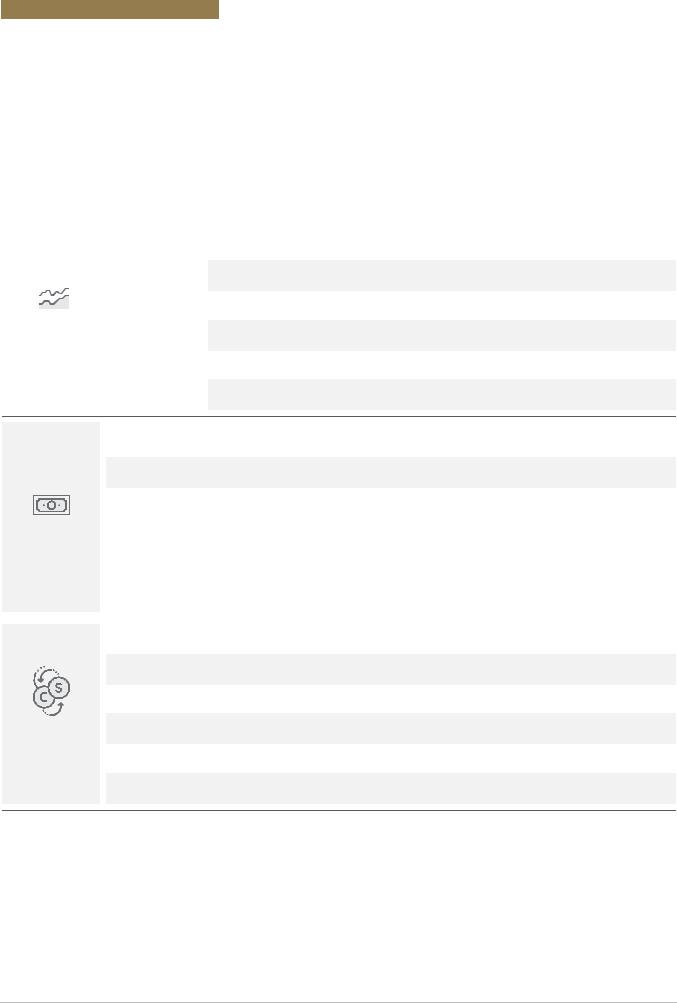
vk.com/id446425943
Standard Chartered Bank
Global Market Outlook | 2 July 2019
Figure 5
Our Tactical Asset Allocation views (12m) USD
Asset class |
|
Sub-asset class |
Relative outlook |
Rationale (+ Positive factors II – Negative factors) |
|
|
|
|
|
|
|
|
|
|
|
|
US |
|
|
|
|
|
Asia ex-Japan |
|
|
|
|
|
Euro area |
|
|
|
Equities |
|
Other EM |
|
|
|
|
|
UK |
|
|
|
|
|
Japan |
|
|
|
▲
▼
+Modest earnings growth, fair valuations || - Economic growth concerns
Lower bond yields supportive of higher valuations
+Modest earnings growth, fair valuations || - Trade tensions
Weaker USD, China stimulus would prove supportive
+Modest earnings growth, fair valuations || - Political uncertainty
Softer ECB stance, lower yields are positives
+Modest earnings growth, fair valuations || - Political uncertainty
Higher commodity prices, weaker USD supportive, but trade tensions a risk
+Modest earnings growth, attractive valuations || - Brexit uncertainty
Avoidance of hard-Brexit remains a base case
+Poor earnings growth, attractive valuations || - Weak economic data
Earnings disappointment, muted foreign flows are negatives
EM government (USD)
Asian USD
EM government (local currency)
▲
+Attractive yields, attractive value || - High interest rate sensitivity
Lower Fed rates, weak USD should be supportive
+Attractive yields, reasonable value || - China concentration
Volatility remains low relative to other bonds
+Attractive yields, moderate value || - FX volatility
Policy rate cuts supportive, but FX exposure reduces risk/reward
|
|
|
|
+ Attractive yields || - Expensive valuation, credit quality |
Bonds |
|
DM HY corporate |
||
|
Yield attractive, but expensive |
|||
|
|
|
|
|
|
|
DM IG corporate |
|
+ Moderate yields, moderate value || - High interest rate sensitivity |
|
|
Fairly valued, but need to watch direction of credit quality |
||
|
|
|
||
|
|
DM IG government |
|
+ Moderate value || - Low yields, inflation surprise |
|
|
Easier monetary policy a support, but upside inflation surprise a risk |
||
|
|
|
|
|
|
|
|
|
|
GBP
EUR
CNY
AUD
Currencies
JPY
USD
▲
▲
▼
+Neutral rate differentials, weak USD view || - Hard Brexit
A ‘hard Brexit’ unlikely, but volatility likely
+Positive rate differentials, weak USD view || - US-EU trade tensions
ECB has less room to ease relative to Fed
+Renewed trade talks, weak USD view || - Worsening rate differentials
Resumption of US-China trade talks a positive.
+China stimulus, weak USD view || - Worsening rate differentials
China stimulus a positive, but slowing domestic growth a risk
+Stable differentials, weak USD view || - Volatility
Bouts of risk aversion could offer support
+ Reduced trade risks || - Weakening rate differentials
Interest rate advantage to narrow as Fed likely cuts rates
Source: Standard Chartered Global Investment Committee
Legend:▲Preferred Core holding ▼Less preferred
This reflects the views of the Wealth Management Group |
6 |
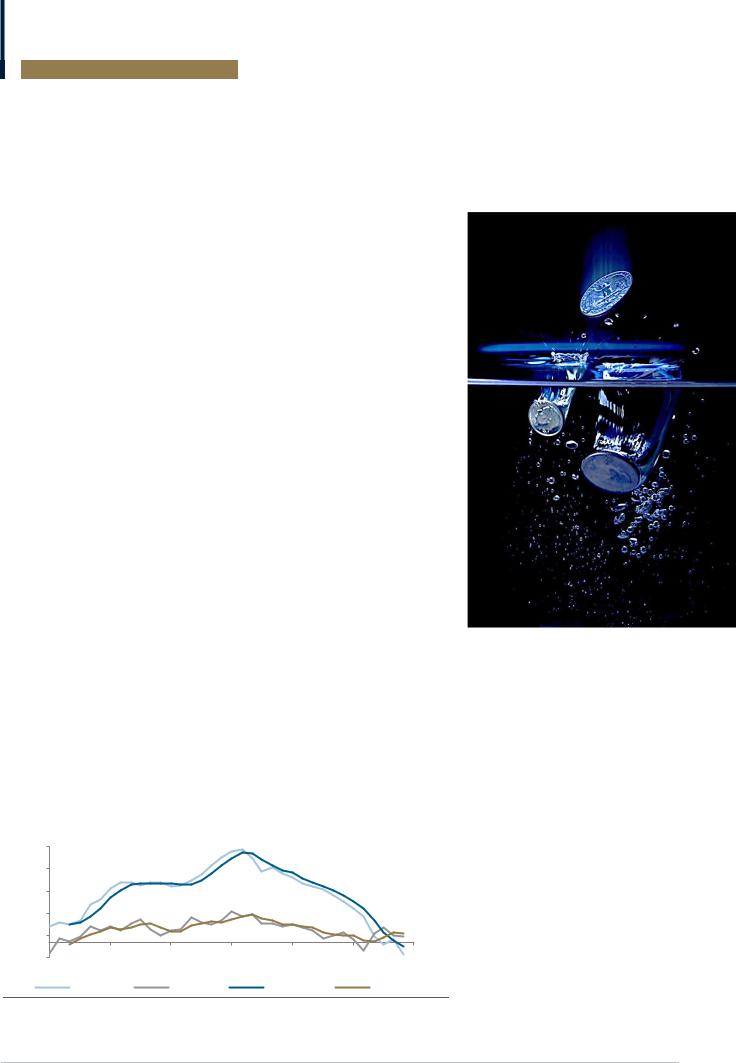
vk.com/id446425943
Standard Chartered Bank
Global Market Outlook | 2 July 2019
3 |
Perspectives on key client questions |
|
|
 What are the implications of a dovish pivot by the Fed and other major central banks?
What are the implications of a dovish pivot by the Fed and other major central banks?
The June FOMC and ECB meetings brought a decisive turn towards easier monetary policies in response to slowing growth and inflation globally. Since the global financial crisis, this is the fourth economic growth moderation (with prior episodes being 2010-11, 2012-13 and 2015-16). With each growth moderation, concerns over the risk of a recession started to increase.
Our Global Investment Committee believes the economic cycle may have more room to run (See Investment Strategy section for more). With the Fed and the ECB signalling potential pre-emptive (insurance) rate cuts and given our expectations for a weaker USD, other central banks are likely to follow suit, easing monetary conditions globally. We see three major implications from this shift.
1.“Insurance cut” by the Fed key to support risk assets. Prior to the previous
‘pre-emptive cuts’ by the Fed (1998 and 1995, when the last cut was not followed by a recession in the next 12 months), credit spreads widened, while bond yields and equities fell, well in advance of the rate cut, not dissimilar to today. However, 12 months after the initial cut, US equities delivered exceptional returns, while bonds with high credit quality offered muted returns. Interestingly, riskier bonds, including High Yield (HY), delivered positive total returns following both rate cuts.
Within equities, we prefer the US. Valuations are arguably not cheap, but can be supported by bond yields staying lower for longer. Investor sentiment remains relatively cautious, with elevated levels of cash held on the sidelines. We see a 70-75% probability for US equities to outperform other equity markets over the next 12 months. Historically, EM assets tend to do well in an insurance cut scenario. Supporting this outlook is the fact that some EM green shoots are evident, although the potential for a flare-up in trade tensions remains an overhang. It remains to be seen if these green shoots will extend and allow for a more sustained constructive view on EM equities.
Figure 6
Slight uptick seen in EM manufacturing PMI indices
Manufacturing PMI indices for EM and DM and their 3m moving averages
|
57 |
|
|
|
|
|
|
|
55 |
|
|
|
|
|
|
Index |
54 |
|
|
|
|
|
|
52 |
|
|
|
|
|
|
|
|
51 |
|
|
|
|
|
|
|
49 |
|
|
|
|
|
|
|
Jun-16 |
Dec-16 |
Jun-17 |
Dec-17 |
Jun-18 |
Dec-18 |
Jun-19 |
|
|
Developed |
Emerging |
|
DM (3m MA) |
|
EM (3m MA) |
Source: Refinitiv, Standard Chartered
This reflects the views of the Wealth Management Group |
7 |

vk.com/id446425943
Standard Chartered Bank
Global Market Outlook | 2 July 2019
2.The search for yield to take fresh impetus. The value of bonds offering a negative yield hit a record high of USD 13trn, with European government bonds now contributing more than 40% of the total negative yielding bond universe globally. Yields on government bonds, income assets and credit spreads have compressed significantly as a result. Investors are increasingly forced to take additional risk (maturity, credit or equity) to meet their income and total return goals. We expect incomegenerating assets to remain well-supported by this lowyield environment. Within fixed income, our preference is for EM USD bonds, which could benefit from both easier Fed policies and a weaker USD.
3.Expect further upside in gold. The shift in central bank rhetoric and a weaker USD have significantly shifted investors’ view on gold, which had been trading in the USD 1,150-1,350 range over the past three years. The recent rally to test levels (USD 1,400) last seen six years ago, combined with dovish central banks, falling yields, rising volume of negative-yielding debt, continuing trade tensions and central bank buying, could trigger further upside price movements, in our opinion. In the short term, we would not be surprised to see a pullback to USD 1,375-1,385, prior to the resumption of its longerterm uptrend (See technical section for more).
Figure 7
Falling yields may force investors to take on additional risk to meet their investment return goals
Yield vs. 1-year volatility. Blue dots represent fixed income segments. Gray dots represent various equity markets*
|
7.0 |
DM HY |
|
EM LC |
|
|
|
|
|
6.0 |
corporates |
sovereigns |
Global |
|
|
||
|
|
|
|
|
|
|||
|
|
|
|
equities |
|
US |
||
|
|
|
|
|
|
|||
(%) |
5.0 |
EM USD |
|
|
|
|
|
|
4.0 |
sovereigns |
Developed |
|
|
Emerging |
|||
Asia credit |
|
|
markets |
|||||
Yield |
|
markets |
Europe |
|
||||
3.0 |
|
DM IG |
|
Japan |
||||
|
|
|
|
|||||
|
|
|
|
|
|
|||
|
|
|
|
|
|
|
|
|
|
2.0 |
corporates |
|
|
Asia ex- |
|
||
|
1.0 |
|
DM IG govt |
|
Japan |
|
|
|
|
|
|
|
|
|
|||
|
0.0 |
|
bonds |
|
|
|
|
|
|
|
|
|
|
|
|
|
|
|
0.0 |
3.0 |
6.0 |
9.0 |
12.0 |
15.0 |
18.0 |
|
|
|
|
|
Volatility (1y) |
|
|
|
|
Source: Bloomberg, Standard Chartered
* Equity yield equals dividend plus buyback yield
Figure 8
Bonds with negative yields hit a record high of USD 13trn on
the back of central banks’ dovish pivot, buoying gold prices
Amount of negative-yielding debt universe vs. gold price (RHS)
|
|
14,000 |
|
|
|
$1,500 |
yieldingNegativedebt |
|
12,000 |
|
|
|
$1,400 |
outstanding($Bn) |
|
|
|
|
||
10,000 |
|
|
|
|
||
8,000 |
|
|
|
$1,300 |
||
|
|
|
|
|
||
|
|
|
|
|
|
|
|
|
6,000 |
|
|
|
$1,200 |
|
|
|
|
|
|
|
|
|
4,000 |
|
|
|
|
|
|
2,000 |
|
|
|
$1,100 |
|
|
|
|
|
|
|
|
|
0 |
|
|
|
$1,000 |
|
|
Jun-16 |
Mar-17 |
Dec-17 |
Sep -18 |
Jun-19 |
|
|
Ma rke t Value of Ne gati ve Yie lding Debt |
Gold (RHS) |
|||
Source: Bloomberg, Standard Chartered
 A weaker US dollar – why does it matter?
A weaker US dollar – why does it matter?
USD strength over the past year has influenced the performance of various asset classes. Our Global
Investment Committee believes the Fed’s firm dovish shift has opened the door for USD weakness on both a short- (1- 3 month) and longer-term (6-12 month) perspective. Currencies and commodities may reflect this change more swiftly, but the long-term effects on both equities and bonds should be significant as well.
What has happened?
From a monetary policy context, the Fed appears to have reacted to growing global economic uncertainty triggered by the manufacturing slowdown, the trade war and the plunge in inflation expectations. Chairman Powell’s dovish tone helped send interest rate expectations even lower. Since the beginning of the Fed tightening cycle in 2015, USD strength had been sustained by attractive interest rate differentials, particularly vis-à-vis other DM central banks. But as markets price in further rate cuts and given that the Fed has more room to cut, unlike some of its counterparts, the gap should finally narrow and, therefore, weigh down on the USD.
Looking at technicals, after a (failed) initial bullish breakout in late April-early May, the USD (as indicated by the DXY index) has taken a dovish turn as investors anticipated the dovish change in stance by the Fed. More importantly, the USD broke through significant support levels on the back of (still) low volatility. Any pickup in volatility could increase confidence of true breakout towards lower levels.
This reflects the views of the Wealth Management Group |
8 |
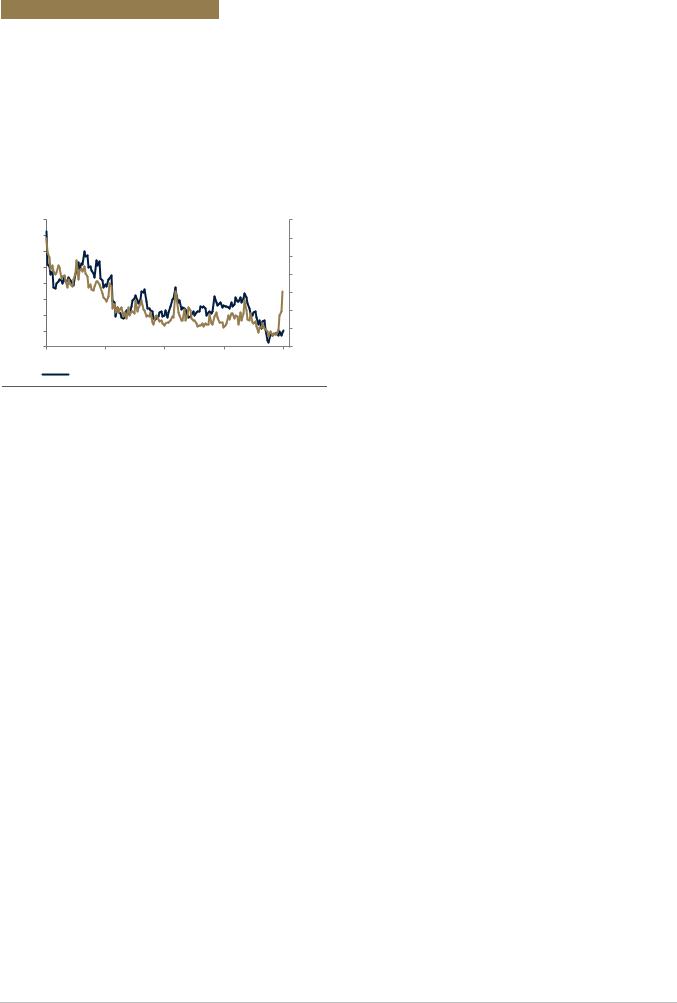
vk.com/id446425943
Standard Chartered Bank
Global Market Outlook | 2 July 2019
Figure 9
USD short-term volatility measures have remained low
3m implied volatility measures for gold and USD (as indicated by DXY Index)
|
13 |
|
|
|
21 |
|
|
12 |
|
|
|
19 |
|
|
|
|
|
|
|
|
|
11 |
|
|
|
17 |
|
|
|
|
|
|
|
|
Index |
10 |
|
|
|
15 |
Index |
|
|
|
|
|||
9 |
|
|
|
|
||
8 |
|
|
|
13 |
||
|
|
|
|
|
|
|
|
7 |
|
|
|
11 |
|
|
|
|
|
|
|
|
|
6 |
|
|
|
9 |
|
|
|
|
|
|
|
|
|
5 |
|
|
|
7 |
|
|
Jun-16 |
Mar-17 |
Dec-17 |
Sep-18 |
Jun-19 |
|
DXY 3m Implied Vol |
|
Gold 3m Implied Vol(RHS) |
|
Source: Bloomberg, Standard Chartered
What does it mean for investors?
Our Global Investment Committee is biased towards a weaker USD (refer to the FX section), which we believe will be positive for investors. We see three positive implications from USD weakness on various asset classes.
1.In the currency space, we expect the EUR to benefit. We believe that as China and other Asian economies recover
on the back of fiscal and monetary stimulus, global growth could stabilise and sentiment within the Euro area could turn more positive.
A break lower in the USD could reduce the interest repayment burden of EMs, providing relief to their respective financial positions, in turn supporting our ongoing positive stance on EM USD Government bonds.
2.From an equity perspective, both US and Asia exJapan equities can benefit from a lower USD. All else equal, in the US, large caps with higher external revenues would see their foreign revenues face lower headwinds, while Asia ex-Japan economies could benefit from increased inflows spurred by a lower USD.
3.Commodities are a direct beneficiary as they are priced in USD and tend to display negative correlation to the USD. Gold has already benefitted from the turn lower in the USD (albeit it has also surged because of the decrease in US real yields) and our committee’s assessment is that gold can potentially have further upside.
This reflects the views of the Wealth Management Group |
9 |
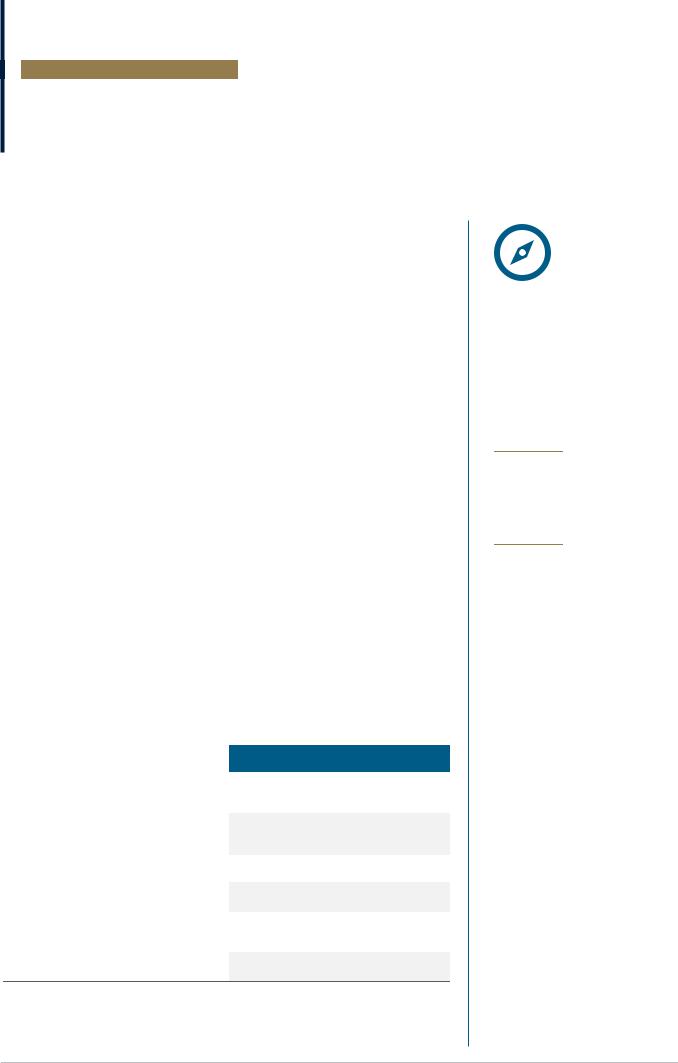
vk.com/id446425943
Standard Chartered Bank
Global Market Outlook | 2 July 2019
6 Macro overview
Doves everywhere
•Core scenario: Our Global Investment Committee believes the dovish turn by global central banks amid slowing inflation and China’s policy easing are likely to help soften the growth impact of trade tensions and previous Fed tightening.
•Policy outlook: We now expect the Fed to cut rates 1-2 times in 2019 and see increased, albeit still-low, chances of more cuts in 2020. We also expect the ECB and the PBoC to ease policy further over the next 12 months.
•Risks: Global trade and geopolitical tensions remain the biggest sources of downside risk. Reduced prospects of further Fed tightening and higher chances of global monetary easing are potential sources of support for risky assets.
Core scenario
The decisively dovish policy turn by the Fed and ECB has raised expectations for other central banks in Developed Markets (DM) and Emerging Markets (EM) to lower rates. Our Global Investment Committee believes this turn in the global policy outlook, along with China’s targeted fiscal and monetary easing, should be sufficient to stabilise global growth and help offset the broad-based impact from US-China trade tensions. Inflation expectations have fallen worldwide, which supports easier monetary policies. Hence, we see only a 35% probability of a US recession in the next 12 months (slightly higher than 30% in May), enabling the 10- year-long US economic expansion set a new record in terms of longevity. Moreover, a dovish Fed, resulting in a weaker USD, is likely to ease global financial conditions*. While the US and China have agreed to restart trade talks, the biggest risk is any further escalation in trade or geopolitical tensions.
Figure 10
Central banks worldwide have turned decisively dovish
|
|
|
Benchmark |
Fiscal |
Region |
Growth |
Inflation |
rates |
policy |
US |
● ● |
|||
Euro |
○ |
● |
● |
|
area |
||||
|
|
|
|
|
UK |
|
|
|
|
Japan |
○ |
● |
● |
|
|
|
|
|
|
JapanAsia ex- |
● ● |
|||
EM ex- |
|
|
● |
|
Asia |
||||
|
|
|
|
|
Comments
The Fed is likely to cut rates for the first time in more than 10 years to stabilise growth and offset the impact of trade risks. Slowing inflation helps
The ECB is also likely to ease policy further as inflation expectations slump to all-time lows and US-China trade tensions hurt manufacturers
We believe ‘hard Brexit’ is unlikely even if Boris
Johnson becomes PM, given political constraints
The BoJ is increasingly likely to ease policy further as external risks mount with global trade tensions
Trade uncertainty continues to weigh on the outlook. This implies further policy easing by China and other Asian central banks
The Fed’s dovish shift and a weaker USD enable EM central banks to cut rates; differentiation key
Source: Bloomberg, Standard Chartered
Legend:●Supportive of risk assets Neutral ○Not supportive of risk assets
*Financial conditions refer to a combination of the USD (lower = easier conditions); corporate bond yield premiums (lower = easier); equity market levels (higher = easier); and interest rates (lower = easier). Generally, easier financial conditions are supportive of economic growth and asset prices.
IMPLICATIONS
FOR INVESTORS
The Fed to cut rates 1-2 times in 2019
The ECB to ease further and the BoJ to maintain its highly accommodative monetary policy over the next 12 months
China to continue with further targeted easing of fiscal and monetary policies to support domestic growth
This reflects the views of the Wealth Management Group |
10 |
